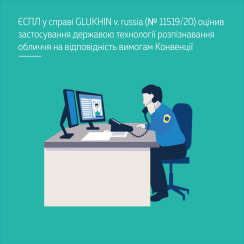Contact center of the Ukrainian Judiciary 044 207-35-46

The use of real-time facial recognition technology without the application of appropriate procedural safeguards and supervisory control mechanisms established by law constitutes a violation of Article 8 of the Convention for the Protection of Human Rights and Fundamental Freedoms.
In the circumstances of the case, on 23 August 2019, the applicant, Mr. Nikolay Glukhin, held a solitary picket in support of another political activist, Mr. Kotov, by travelling in the Moscow metro with a human-sized cardboard cutout of the latter and a banner reading "You must be joking. I am Konstantin Kotov. I am facing up to five years under [Article] 212.1 for peaceful protest".
A few days later, the applicant was arrested while travelling by metro.
Mr. Glukhin claimed that police officers had allegedly collected and used screenshots from a social networking site and video from CCTV cameras installed in the Moscow metro stations he had travelled through on 23 August 2019 to identify him, and a few days later used real-time facial recognition technology to locate and arrest the applicant.
The applicant complained that his subsequent conviction of an administrative offence for failing to notify the authorities of his solitary picket and the use of facial recognition technology in the processing of his personal data had violated his rights under the Convention.
In assessing the circumstances of the case under Article 10 of the Convention, the European Court of Human Rights concluded that the applicant's actions were his way of expressing his opinion on a matter of public concern and that the intolerance shown by the authorities towards his solitary picket, which was undoubtedly peaceful, was not justified by "relevant or sufficient reasons".
Referring to the general principles developed by the ECtHR under Article 8 of the Convention, the Court noted that the Convention institutions consider that the monitoring of a person's actions and movements in a public place by means of a camera which does not record visual data does not in itself constitute a form of interference with privacy. However, privacy concerns may arise once there is a systematic or permanent record of such personal information, including photographs of an identified individual.
The ECtHR assessed the evidence and explanations provided by the parties (inter alia, the existence of valid orders for the installation of video surveillance cameras in the Moscow metro, which ensure the detection and identification of certain persons by video surveillance systems; available public information on numerous cases related to the use of facial recognition technology to identify protesters in russia; the absence of any other explanation by the government for the rapid identification of Mr. Glukhin, etc.) and found that in this case the applicant had indeed been subjected to facial recognition technology.
In its analysis of the existence and proportionality of the interference with the applicant's rights, the ECtHR found that the respondent State's legislation, in particular the provisions of the Law "On the Processing of Personal Data" of 27 July 2006 No. 152-ФЗ, in force at the time of the events, according to Section 11(2) of which the processing of personal biometric data of a person without his/her consent was lawful in the case of "administration of justice, as well as in cases provided for by the legislation on defence, security, anti-terrorism, transport security, anti-corruption and operational search activities", which the Government used as the legal basis for the interference with the applicant's rights, were too broadly drafted and did not contain any restrictions as to the nature of the situations which could lead to the use of facial recognition technology, the intended purposes, the categories of persons who could be targeted or the processing of confidential personal data. In addition, the Government did not refer to any procedural safeguards, supervisory control mechanisms and available remedies that should accompany the use of facial recognition technology in russia. In other words, the national legislation did not even provide for recording in official documents/databases or informing a person/public about the use of facial recognition technology.
The ECtHR considered the measures taken against the applicant to be "particularly intrusive" because they related to real-time facial recognition technology. The processed personal data contained information about the applicant's participation in a peaceful protest and therefore revealed his political views. As a result, they fell within special categories of confidential data that required a higher level of protection.
The ECtHR noted that the use of such particularly intrusive technology to identify and arrest participants in peaceful protests may have a negative impact on the rights to freedom of expression and freedom of assembly.
In such circumstances, the use of facial recognition technology to identify the applicant did not meet a "pressing social need" and was incompatible with the ideals and values of a democratic society governed by the rule of law, which the Convention seeks to guarantee and uphold.
A more detailed description of this judgment will be available in the next ECtHR case law review, while the previous review is available at https://is.gd/zBq7LX.
The official text of the ECtHR judgment in the case of GLUKHIN v. russia is available on the ECtHR website at https://hudoc.echr.coe.int/rus?i=001-225655.